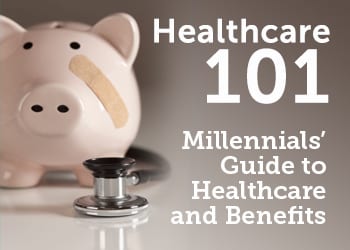Healthcare 101: Millennials' Guide to Healthcare and Benefits
May 7, 2016

If you’re a recent graduate, you may have also just landed your first job — congratulations! Once you have that, it may seem like the hard choices are over (at least for a little while). However, accepting a job comes with a slew of options for health insurance, retirement contributions and other employee benefits. If you don’t have much experience with health insurance, it can be confusing to find the option that is right for you. Millennial decision-makers can use the following guide to healthcare to make an informed choice.
Definitions and Terms
Understanding the basic terminology helps you properly compare the costs and benefits associated with different policies. Some common terms include:
Premium: The premium is the amount that must be paid for your health insurance plan. Employers may often pay a portion of this premium, but the rest is typically deducted from your paycheck.
Deductible: The deductible is the amount that you must pay out-of-pocket before your health insurance benefits kick in. For example, if you have a $1,000 deductible, you are responsible for paying the first $1,000 of healthcare costs each year. After that, your insurance company covers the cost of eligible healthcare expenses.
Copayment: Some insurance policies require you to pay a copayment (this can vary greatly depending on the provider and policy, but may be in the range of $20 to $40) when you visit a medical professional. You pay this money up front when you receive healthcare services.
Coinsurance: Other insurance policies require that you pay coinsurance. Coinsurance means that you pay a percentage of the bill (perhaps 10% or 20%), in addition to any deductible amount. For example, if your insurance plan has a 10 percent deductible, you would have to pay $20 of a $200 bill for healthcare services.
Things to Know Before Choosing a Health Insurance Plan
There are a lot of variables to consider when choosing a health insurance plan. The first thing to think about is the interplay between your monthly premiums and the deductible. In general, a higher deductible means that you will have lower premiums. This is because you agree to pay more money out-of-pocket if you use healthcare services. To decide what deductible amount is best, consider the amount of money you could afford to pay in the event of a catastrophic event. Lowering your premiums by raising the deductible may seem like an attractive way to save money, but it can also leave you facing a large bill in the case of an emergency.
It is also smart to consider what doctors are “in network” for a given policy. Most insurance providers work with a network of providers who are covered by their plan. This allows them to negotiate lower rates, reducing overall costs. In some cases, you can visit an out-of-network healthcare provider, but it will probably cost you more than visiting an in-network provider. Ask questions about in-network versus out-of-network costs to ensure your preferred provider is covered.
Finally, ask how a potential plan covers prescription medications. Most insurance providers divide medications into different drug tiers. Choosing a lower tier of drug (often generics) typically saves you money compared to the highest drug tier.
The good news is that CareSpot accepts most insurance plans! So if you happen to get sick at your new job, rest assured you can get same-day treatment at one of our convenient locations.
